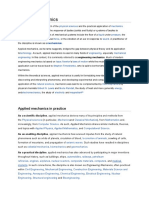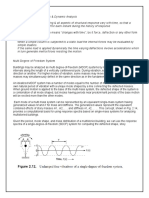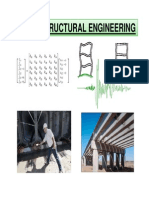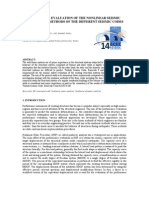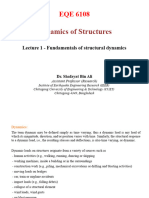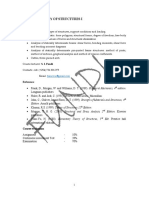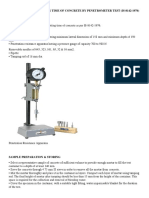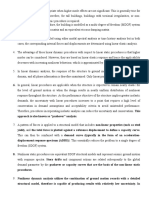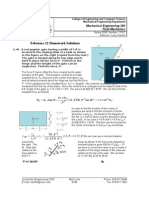SD Print
SD Print
Uploaded by
vempadareddyCopyright:
Available Formats
SD Print
SD Print
Uploaded by
vempadareddyOriginal Description:
Copyright
Available Formats
Share this document
Did you find this document useful?
Is this content inappropriate?
Copyright:
Available Formats
SD Print
SD Print
Uploaded by
vempadareddyCopyright:
Available Formats
Structural Dynamics
The essence of earthquake effects on structures is the dynamic nature of earthquake loading.
Mechanics as a branch of physics is subdivided into statics and dynamics.
Statics studies systems in static equilibrium, i.e., in a state where the system internal forces
counterbalance external forces acting on the system.
Static refers to the fact that the state of the system and the applied forces do not vary in
time; they are time-independent.
Dynamics is the study of systems subject to time-varying applied forces.
As a consequence of the time variability of the applied forces, the system’s internal forces
and its state (defined in terms of displacement and deformation) also vary with time — the
system’s response involves motion.
While a static problem has a single time-independent solution, the solution of a dynamic
problem involves a description of the system’s state at every time point within the period
of study.
The appearance of inertia effects associated with mass in motion is another key distinction
of dynamic problems.
Structural dynamics can be considered as the study of a body or structure in dynamic
equilibrium
The mathematical expression of this equilibrium is the equation of motion
While the static equilibrium equation expresses the balance between the structure’s internal
forces and externally applied forces, the equation of motion expresses the equilibrium of
internal and external force terms (which are exactly the same as in the static equilibrium
equation) and the mass inertia and damp ing effects.
As the inertia term involves the second derivative and the damping term the first derivative
of the displacement with respect to time, the equation of motion is a second-order
differential equation with constant coefficients.
Modal Analysis and Structural Dynamics
Modal Analysis is the study of the dynamic character of a system which is defined
independently from the loads applied to the system and the response of the system.
Structural dynamics is the study of how structures respond when subjected to applied loads.
Many times, in one form or another, the modal characteristics of the structure is used to
determine the response of the system.
Causes and effects of structural vibration
Increasing vehicle weights and traffic volumes, requires that designers take vibration of
structures into account at the design stage. Sometimes the trouble caused by vibration is merely
the nuisance resulting from sound transmission or the feeling of insecurity arising from the
swaying of tall buildings and light structures such as certain types of footbridge. Occasionally,
however, vibration can lead to dynamic instability, fatigue cracking or incremental plastic
deformations. The first two types of problem may lead to a reduction in utilization of a
structure. The latter may lead to costly repairs if discovered in time or, if not, to complete
failure with possible loss of human life.
Long-term vibration induced by traffic can lead to fatigue in structural elements and should not
be underestimated. A number of old railway bridges have started to develop fatigue cracks in
the gusset plates, which have had to be replaced. The effect of traffic is not confined to bridges
– it must also be taken into account when the foundations of buildings situated next to railway
lines or roads carrying heavy traffic are being designed. It is interesting that many ancient
buildings such as cathedrals, which have been built next to main roads, tend to lean towards
the road and, in many cases, also show signs of cracks as a result of centuries of minute
amplitude vibrations caused by carts passing on the cobbled road surfaces.
A fault trace is the intersection of a geological faultwith the ground surface, leaving a
visible mark. A fault scarp is a small step or offset on the ground surface where one
side of a fault has moved vertically with respect to the other.
You might also like
- Introduction To Structural DesignDocument6 pagesIntroduction To Structural DesignKashif AfridiNo ratings yet
- Structural Dynamics of Earthquake Resistant BuildingsDocument13 pagesStructural Dynamics of Earthquake Resistant BuildingsAnil KadbhaneNo ratings yet
- Seismic DampingDocument5 pagesSeismic DampingFahadmeyoNo ratings yet
- Study Notes (Materials Collected For Study / Information, Collection Document)Document10 pagesStudy Notes (Materials Collected For Study / Information, Collection Document)Tapas BanerjeeNo ratings yet
- Course Title: Advanced Dynamics of Structure Course Code: MTSE-102 Semester: IDocument21 pagesCourse Title: Advanced Dynamics of Structure Course Code: MTSE-102 Semester: IEr Ashish PoudelNo ratings yet
- Module 1: Introduction: Review of Basic Concepts in Mechanics Lecture 1: IntroductionDocument19 pagesModule 1: Introduction: Review of Basic Concepts in Mechanics Lecture 1: IntroductionSpurthi SrinivasNo ratings yet
- 13001319046Document9 pages130013190469046Mayank RanjanNo ratings yet
- A Case For Use of Dynamic Analysis in Designing For Earthquake ForcesDocument4 pagesA Case For Use of Dynamic Analysis in Designing For Earthquake Forcesbipinsh01No ratings yet
- Chapter 1Document28 pagesChapter 1Sana'a AamirNo ratings yet
- Structural Dynamics Lecture 1Document38 pagesStructural Dynamics Lecture 1jahanzaibch100% (1)
- Applied Mechanics in PracticeDocument10 pagesApplied Mechanics in PracticeGautham NithinNo ratings yet
- AdityaDocument144 pagesAdityaK RaghuNo ratings yet
- 01 Static & Dynamic AnalysisDocument34 pages01 Static & Dynamic AnalysisVijith29No ratings yet
- Literature ReviewDocument8 pagesLiterature ReviewGio AsombradoNo ratings yet
- Lecture Notes CT 4145Document132 pagesLecture Notes CT 4145mohdsolihat1No ratings yet
- Paper 4 11038 Full Paper HrkhoshnoudDocument9 pagesPaper 4 11038 Full Paper HrkhoshnoudhamidstructureNo ratings yet
- Forming ProcessDocument25 pagesForming ProcessVishnu BoyapatiNo ratings yet
- Earth Quake EngineeringDocument6 pagesEarth Quake Engineeringbabu1434No ratings yet
- Structural Dynamics Lecture 1Document36 pagesStructural Dynamics Lecture 1mian100% (3)
- Introduction To Structural EngineeringDocument7 pagesIntroduction To Structural EngineeringCjoy De RoxasNo ratings yet
- Statically Indeterminate Structures (Statics)Document2 pagesStatically Indeterminate Structures (Statics)cowboys20No ratings yet
- Steel Structures - Assignment No. 2Document19 pagesSteel Structures - Assignment No. 2Engr MahwishNo ratings yet
- Report On Pushover AnalysisDocument14 pagesReport On Pushover Analysiskandarp majmudar100% (1)
- Plate #1 Introduction Read About Structural Analysis of Theory of StructuresDocument13 pagesPlate #1 Introduction Read About Structural Analysis of Theory of StructuresCristina Mauren P. PajesNo ratings yet
- Advanced Topics in Offshore Wind Turbines Design: Franco - Bontempi@uniroma1.itDocument11 pagesAdvanced Topics in Offshore Wind Turbines Design: Franco - Bontempi@uniroma1.itkhalijimhNo ratings yet
- Torsional Vibration of Eccentric Building Systems: September 2011Document25 pagesTorsional Vibration of Eccentric Building Systems: September 2011Mohammed AshrafNo ratings yet
- Structural Dynamics and Earthquake Engineering-Ch 1-5Document58 pagesStructural Dynamics and Earthquake Engineering-Ch 1-5Lucas PérezNo ratings yet
- Compilation Final OutDocument5 pagesCompilation Final OutJung KookNo ratings yet
- Typology of Progressive CollapseDocument8 pagesTypology of Progressive CollapseNoble Obeng-AnkamahNo ratings yet
- A Comparative Evaluation of The Nonlinear Seismic Performance Methods of The Different Seismic CodesDocument8 pagesA Comparative Evaluation of The Nonlinear Seismic Performance Methods of The Different Seismic CodesMehmet Burak YılmazNo ratings yet
- Chapter 1 PDFDocument10 pagesChapter 1 PDFKanenus B FinfinneeNo ratings yet
- Fundamentals of Structural DynamicsDocument45 pagesFundamentals of Structural DynamicsAsif ZubairNo ratings yet
- Dynamic Response To Distributed Masses To Variable Velocities For General Classical Boundary ConditionsDocument57 pagesDynamic Response To Distributed Masses To Variable Velocities For General Classical Boundary ConditionsJimoh SULE Adekunle100% (1)
- Module 1 Theory of PlasticityDocument20 pagesModule 1 Theory of Plasticityxavier sethuNo ratings yet
- Wind Stability Engineering in High Rise BuildingsDocument3 pagesWind Stability Engineering in High Rise BuildingsVacunador SeniorNo ratings yet
- EQ-Basics of Structural Dynamics-PGPDocument55 pagesEQ-Basics of Structural Dynamics-PGPParesh PatelNo ratings yet
- Study On The Reduction of The General Overall TorsDocument12 pagesStudy On The Reduction of The General Overall Torswladimir ramrezNo ratings yet
- Solid Mechanics 94 10Document89 pagesSolid Mechanics 94 10landatoNo ratings yet
- Tugas 1Document22 pagesTugas 1Tiara OktavianiNo ratings yet
- TOS I Topic 1Document12 pagesTOS I Topic 1Daisy OgollaNo ratings yet
- Structural Analysis - WikipediaDocument10 pagesStructural Analysis - WikipediaEn Iyisi İnşaat MühendisiNo ratings yet
- Analytical and Mathematical Analysis of the VibrationDocument23 pagesAnalytical and Mathematical Analysis of the VibrationmateusNo ratings yet
- Chapter 1Document13 pagesChapter 1Wendimu TolessaNo ratings yet
- Scs 2004004Document12 pagesScs 2004004daisymanuval1998No ratings yet
- Module 5 Structural DynamicsDocument16 pagesModule 5 Structural DynamicsEr Digvijay SinghNo ratings yet
- Respon Struktur Akibat Beban Seismik Pada Gedung Dengan Model Penampang Struktur Kolom Tak SeragamDocument11 pagesRespon Struktur Akibat Beban Seismik Pada Gedung Dengan Model Penampang Struktur Kolom Tak SeragamAnonymous esM09O2spNo ratings yet
- Structural Theory 1 Part 1Document14 pagesStructural Theory 1 Part 1Christian ConsignaNo ratings yet
- Loads On StructuresDocument11 pagesLoads On Structuresmoy092No ratings yet
- Theory of Structure IDocument30 pagesTheory of Structure IBiranu ItichaNo ratings yet
- Der Luft-Und Raumfahrtkonstruktionen, University of Stuttgart, West GermanyDocument49 pagesDer Luft-Und Raumfahrtkonstruktionen, University of Stuttgart, West GermanyAmenNo ratings yet
- Stress AnalysisDocument13 pagesStress AnalysismaloyNo ratings yet
- Not Move or CollapseDocument3 pagesNot Move or CollapseWahyudi AlaskiNo ratings yet
- Finite Element Analysis in Structural EngineeringDocument3 pagesFinite Element Analysis in Structural EngineeringBaherNo ratings yet
- Vibration Theory in Earthquake EngineeringDocument1 pageVibration Theory in Earthquake EngineeringMaan VillarosaNo ratings yet
- Seismic Analysis of Multistorey Building With Floating Column-656Document12 pagesSeismic Analysis of Multistorey Building With Floating Column-656kaye02tuallaNo ratings yet
- Theories of Failure: Working Stress and Failure Theories A Simplified ApproachDocument3 pagesTheories of Failure: Working Stress and Failure Theories A Simplified ApproachAnonymous TX2OckgiZNo ratings yet
- Assessing Seismic Resilience in Suspension Bridges: Nonlinear Modeling and Strategies for Mitigating FailuresFrom EverandAssessing Seismic Resilience in Suspension Bridges: Nonlinear Modeling and Strategies for Mitigating FailuresNo ratings yet
- Introduction to Design of Building StructuresFrom EverandIntroduction to Design of Building StructuresRating: 4 out of 5 stars4/5 (22)
- WAC and PorosityDocument11 pagesWAC and PorosityvempadareddyNo ratings yet
- Representative Student's NameDocument2 pagesRepresentative Student's NamevempadareddyNo ratings yet
- Questions For The Revised BloomDocument2 pagesQuestions For The Revised BloomvempadareddyNo ratings yet
- Print SDDocument4 pagesPrint SDvempadareddyNo ratings yet
- Tep - Set 1Document1 pageTep - Set 1vempadareddyNo ratings yet
- Self Healing Concrete - Sample DetailsDocument1 pageSelf Healing Concrete - Sample DetailsvempadareddyNo ratings yet
- List of Paper Publications Journals: InternationalDocument7 pagesList of Paper Publications Journals: InternationalvempadareddyNo ratings yet
- Acsge 2018 Extended Abstract TemplateDocument2 pagesAcsge 2018 Extended Abstract TemplatevempadareddyNo ratings yet
- Principles of SafetyDocument24 pagesPrinciples of SafetyvempadareddyNo ratings yet
- Setting Time of ConcreteDocument2 pagesSetting Time of ConcretevempadareddyNo ratings yet
- Notes For Print TEPDocument21 pagesNotes For Print TEPvempadareddyNo ratings yet
- PGS 506 DISASTER MANAGEMENT 1+0 (E-Course)Document1 pagePGS 506 DISASTER MANAGEMENT 1+0 (E-Course)vempadareddy0% (1)
- Springer Journal Paper On Bacterial ConcreteDocument12 pagesSpringer Journal Paper On Bacterial Concretevempadareddy100% (1)
- Railway FAQDocument9 pagesRailway FAQvempadareddyNo ratings yet
- BTech Thesis GuidelinesDocument17 pagesBTech Thesis Guidelinesvempadareddy100% (1)
- Arch ActionDocument14 pagesArch ActionvempadareddyNo ratings yet
- Mlrit Int ConfDocument8 pagesMlrit Int ConfvempadareddyNo ratings yet
- I. Teaching: Performance in The Last Two Completed SemestersDocument7 pagesI. Teaching: Performance in The Last Two Completed SemestersvempadareddyNo ratings yet
- Linear and Non-Linear Dynamic AnalysisDocument9 pagesLinear and Non-Linear Dynamic AnalysisvempadareddyNo ratings yet
- Linear and Non-Linear Dynamic AnalysisDocument10 pagesLinear and Non-Linear Dynamic AnalysisvempadareddyNo ratings yet
- How Is HRA Decided?: Basic SalaryDocument1 pageHow Is HRA Decided?: Basic SalaryvempadareddyNo ratings yet
- Imrf Journals: Editorial Board Nomination FormDocument3 pagesImrf Journals: Editorial Board Nomination FormvempadareddyNo ratings yet
- CVR Jour No.11Document112 pagesCVR Jour No.11vempadareddyNo ratings yet
- Nat Conf Mrec - DR VSRDocument8 pagesNat Conf Mrec - DR VSRvempadareddyNo ratings yet
- Alt GPTDocument1 pageAlt GPTEnrique DuarteNo ratings yet
- Apar Transformer Oil PDS - To 1020 60 U PDFDocument1 pageApar Transformer Oil PDS - To 1020 60 U PDFmaa vaishnavi ventureNo ratings yet
- Johnson Essentials 6e Chap003 LecturePPTDocument44 pagesJohnson Essentials 6e Chap003 LecturePPTAnthony AnthonyNo ratings yet
- 135 137 PMR Jul09Document3 pages135 137 PMR Jul09syaNo ratings yet
- Objective Type KVPY QuestionsDocument29 pagesObjective Type KVPY QuestionsAnkur Singh75% (4)
- Chemistry Important Questions-2015-2016Document19 pagesChemistry Important Questions-2015-2016janu50% (4)
- Syllabus - Nuclear PhysicsDocument3 pagesSyllabus - Nuclear PhysicsMANOJ SHETTYNo ratings yet
- BEE Module 1Document17 pagesBEE Module 1John crax100% (1)
- 3.3 PfmeaDocument5 pages3.3 PfmeaEaswaranNo ratings yet
- Effect and Role of Salt in Cellulosic Fabric DyeingDocument6 pagesEffect and Role of Salt in Cellulosic Fabric DyeingAurenio RibeiroNo ratings yet
- Rear Cab Compartment Dash: Electrical System 785D Off-Highway TruckDocument12 pagesRear Cab Compartment Dash: Electrical System 785D Off-Highway TruckDaniel Alfonso Diaz FloresNo ratings yet
- Fluid Transient Flow Concepts: Classification of Flow. DefinitionsDocument35 pagesFluid Transient Flow Concepts: Classification of Flow. DefinitionsKaren Johnson0% (1)
- CHEM F313: Instrumental Methods of Analysis: UV-Vis Spectrometry (Contd.)Document9 pagesCHEM F313: Instrumental Methods of Analysis: UV-Vis Spectrometry (Contd.)AYUSH SHARMANo ratings yet
- Hall PFDocument14 pagesHall PFkhadi12345.harNo ratings yet
- Swapping Out Silicone in Our Skin and Hair ProductsDocument7 pagesSwapping Out Silicone in Our Skin and Hair Productsmansi chaudhariNo ratings yet
- Periodic Trends Lesson PlanDocument6 pagesPeriodic Trends Lesson PlanLauren Gonyea100% (4)
- Corrosion Guide - Material BehaviorDocument11 pagesCorrosion Guide - Material Behaviorkaruna346No ratings yet
- 12 General Chemistry 2Document54 pages12 General Chemistry 2Darlin Maree JamonNo ratings yet
- Method 625-1 2016Document60 pagesMethod 625-1 2016maria angel galéNo ratings yet
- VSUN320-60M VSUN550-144MH: YearsDocument2 pagesVSUN320-60M VSUN550-144MH: YearsPatrick FerreiraNo ratings yet
- US3014784Document2 pagesUS3014784SatyamSahuNo ratings yet
- HW 03Document7 pagesHW 03bookwprk122134No ratings yet
- K12 Outreach Solvent Extraction DRAFTDocument8 pagesK12 Outreach Solvent Extraction DRAFTDakota EllisonNo ratings yet
- PDS Bohler N ER 316 LDocument1 pagePDS Bohler N ER 316 Lkamals55No ratings yet
- Lecture 21Document9 pagesLecture 21Rithik BawaneNo ratings yet
- B48BA Exam Questions v1Document18 pagesB48BA Exam Questions v1Manmohan SinghNo ratings yet
- Polyvinylsiloxanes in Dentistry: An Overview: Trends in Biomaterials and Artificial Organs July 2013Document10 pagesPolyvinylsiloxanes in Dentistry: An Overview: Trends in Biomaterials and Artificial Organs July 2013aasifNo ratings yet
- Indian Institue of Technology 1Document115 pagesIndian Institue of Technology 1venkatasaivishwesvarNo ratings yet
- Applied Mechanics - WikipediaDocument29 pagesApplied Mechanics - WikipediaUchechukwu MarizuNo ratings yet
- Role of Geology in Petroleum EngineeringDocument16 pagesRole of Geology in Petroleum EngineeringMuhammad Zaid KhanNo ratings yet










